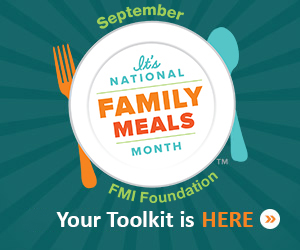By: David Fikes, Executive Director, FMI Foundation

We’ve long known that family meals offer the dynamic duo of benefits, providing better dietary outcomes for the body and improved family functioning for the mind and spirit. Consequently, when asked, Americans tended to say they wanted more family meals than their schedules and energy level allowed them. Then, in a classic be-careful-what-you-wish-for object lesson—suddenly COVID-19 thrust us all into a situation where family meals were not just an easier choice, they were THE choice. After the initial shock of home sheltering wore off and folks settled into the routine, there was a refreshed appreciation for families dining together. The family meal, for many households, became the norm three times a day, plus snacks. But as the COVID-19 days turned into weeks and the weeks turned into months, family meal zeal began to wane. The norm became routine and for many the routine slipped into a chore with the social media tag of #FamilyMealFatigue.
COVID-19 has certainly changed our approach to family meals and perhaps reshaped our attitude about preparing them, but has it affected the benefits and how we perceive them? We wanted to know, so the FMI Foundation funded research to find out and here is what we learned:
- As a result of the global pandemic, Americans are cooking more and having more family meals. An incredible 94% say they are cooking the same amount or more than before the pandemic. And three-quarters of Americans report they are having the same amount or more family meals – both in-person and virtually.
- Family meals still keep us connected. Seventy-one percent (71%) of people who have been eating more in-person meals (and 70% having more virtual meals) agree that "I feel more connected to my family since the pandemic has started."
- People appreciate the emotional benefits from breaking bread together. The preponderance of Americans – 78% – have positive sentiments about family meals such as: “they are a high point of my day,” or “they help to make me feel calm” or “they are an important part of my household’s regular routine.”
- Notably, Americans recognize the nutrition advantages of eating together. More than one-third recognize that they eat better and 40% say that the food they eat is more balanced or healthier than the food they eat when alone.
We also learned that the definition of family is ever evolving. Currently, 77% of those surveyed cohabitate, which means they are sharing meals with significant others, children, other adult family members, friends and roommates. But perhaps the most resounding endorsement of the power of family meals came from this insight: A notable 85% of Americans plan on eating family meals more often or the same amount as they did before the pandemic when things return to a new normal. Whatever our new normal will be, Americans will need to stay physically and emotionally fit, and family meals help with both. Clearly, consumers plan to stay strong with family meals.
Check out how you can help them do so at www.FMIFamilyMeals.com.


